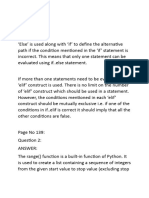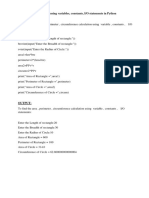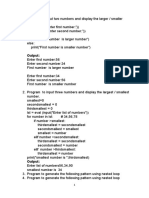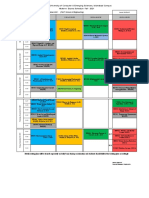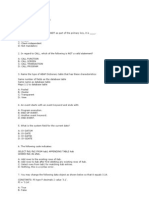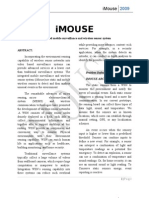Repetition in Python
Uploaded by
shardahospital2009Repetition in Python
Uploaded by
shardahospital2009REPETITIONS IN PYTHON
CHAPTER 7
The range() function returns a sequence of numbers, starting from 0 by default, and increments by 1
(by default), and stops before a specified number.
Syntax
range(start, stop, step)
start Optional. Default is 0
stop Required.
step Optional. Default is 1
Increment or Decrement operators -
In Python += is used for incrementing, and -= for decrementing. In some other languages, there is
even a special syntax ++ and -- for incrementing or decrementing by 1
a += 1
a -= 1
The ‘for loop’
A for loop is used for iterating over a sequence
With the for loop we can execute a set of statements, once for each item in a list.
Syntax
for variable in range (start,stop,step):
print(variable)
EXAMPLE
for x in range(1, 101, 1):
print(x)
Output
1
2
3
:
:
:
100
Displaying numbers horizontally -
Syntax
print(x,end=” ”)
EXAMPLE
for x in range(1, 101, 1):
print(x,end=” ”)
Output
1 2 3 ……………………… 1oo
NOTE - Do example 1 to example 7 in the notebook.
QD: Write the following programs in Python :
1. Program to finds the sum of natural numbers from 21 to 30 (both numbers
inclusive.
SOLUTION
Sum = 0
for x in range(21,31,1):
Sum = sum + x
print(“ The sum of natural numbers from 21 to 30 is :”, Sum)
2. Program to finds the sum of natural numbers m to n, where m and n are input
by the user.
SOLUTION
m= int(input(“Enter a number”))
n = int(input(“Enter second number”))
Sum = 0
for x in range(m,n+1,1):
Sum = sum + x
print(“ The sum of natural numbers from m to n is :”, Sum)
3. Program to finds the sum of all even numbers from m to n, where m and n are
input by the user.
SOLUTION
m= int(input(“Enter a number”))
n = int(input(“Enter second number”))
Sum = 0
for x in range(m,n+1,1):
if(x%2==0):
Sum = sum + x
print(“ The sum of natural numbers from”, m, “to”, n, “is :”, Sum)
4. Program to display the multiplication table of a number entered by the user,
upto 10 times
SOLUTION
m= int(input(“Enter a number for table”))
for i in range(1,11,1):
print(m, "x",i, "=", m*i)
5. Program to display the multiplication table of m, upto n times, where the
number m and n entered by the user.
SOLUTION
m= int(input(“Enter a number for table”))
n = int(input(“Enter second number to print upto…. ”))
Sum = 0
for i in range(1,n+1,1):
print(m, "x",i, "=", m*i)
You might also like
- Amadeus Basic Reservation & Ticketing Manual - SWNo ratings yetAmadeus Basic Reservation & Ticketing Manual - SW27 pages
- Class 11 - Presentation # 5 - Iterative Statements - for loopNo ratings yetClass 11 - Presentation # 5 - Iterative Statements - for loop60 pages
- II Term Std 10 - Revision 5 for Robotics & AINo ratings yetII Term Std 10 - Revision 5 for Robotics & AI19 pages
- 20 Python Coding Questions and Answers For ProgrammingNo ratings yet20 Python Coding Questions and Answers For Programming10 pages
- Programs STD XI Flow of Control and StringNo ratings yetPrograms STD XI Flow of Control and String20 pages
- Basic Exercises for Competitive Programming Python 1st Edition Jan Pol pdf download100% (3)Basic Exercises for Competitive Programming Python 1st Edition Jan Pol pdf download40 pages
- Computer Class XI Programs For Term-1 and Term-2100% (1)Computer Class XI Programs For Term-1 and Term-262 pages
- Comp 150 Exam 1 Overview.: Resources During The ExamNo ratings yetComp 150 Exam 1 Overview.: Resources During The Exam5 pages
- Hikvision Pstor - v1.3.1 - User Manual - EN - 2019607No ratings yetHikvision Pstor - v1.3.1 - User Manual - EN - 201960775 pages
- Senior Account Executive Manager in New York City Resume Martin MaturineNo ratings yetSenior Account Executive Manager in New York City Resume Martin Maturine2 pages
- CARA BELAJAR EFEKTIF - PPTX Pages 1-18 - Flip PDF Download - FlipHTML5No ratings yetCARA BELAJAR EFEKTIF - PPTX Pages 1-18 - Flip PDF Download - FlipHTML518 pages
- Biomedical Signal Processing Prof. Sudipta Mukhopadhyay Department of Electrical and Electronics Communication Engineering Indian Institute of Technology, Lecture - 51 Tutorial - II (Contd.)No ratings yetBiomedical Signal Processing Prof. Sudipta Mukhopadhyay Department of Electrical and Electronics Communication Engineering Indian Institute of Technology, Lecture - 51 Tutorial - II (Contd.)21 pages
- Making It Rain Cloud Based Molecular Simulations For EveryoneNo ratings yetMaking It Rain Cloud Based Molecular Simulations For Everyone13 pages
- This Article Has Multiple Issues. Please Help: Talk Page General Notability Guideline Inline CitationsNo ratings yetThis Article Has Multiple Issues. Please Help: Talk Page General Notability Guideline Inline Citations12 pages
- S7 User Block For The OPC UA Client of A SIMATIC S7-1500No ratings yetS7 User Block For The OPC UA Client of A SIMATIC S7-150040 pages
- Steve Jobs by Walter Isaacson - Book ReviewNo ratings yetSteve Jobs by Walter Isaacson - Book Review3 pages
- Procash 3100: The Solution For All Self-Service Cash TransactionsNo ratings yetProcash 3100: The Solution For All Self-Service Cash Transactions4 pages
- Integrated Mobile Surveillance and Wireless Sensor System100% (1)Integrated Mobile Surveillance and Wireless Sensor System10 pages
- NetFlow_IPFIX Exporting with pmacct – Bits 'n BytesNo ratings yetNetFlow_IPFIX Exporting with pmacct – Bits 'n Bytes6 pages
- CIC RC BOOKING REQUEST FORM - Castillo J Arnold2No ratings yetCIC RC BOOKING REQUEST FORM - Castillo J Arnold21 page
- Modern Systems Analysis and Design 8th Edition Valacich Solutions Manual 1100% (69)Modern Systems Analysis and Design 8th Edition Valacich Solutions Manual 120 pages








